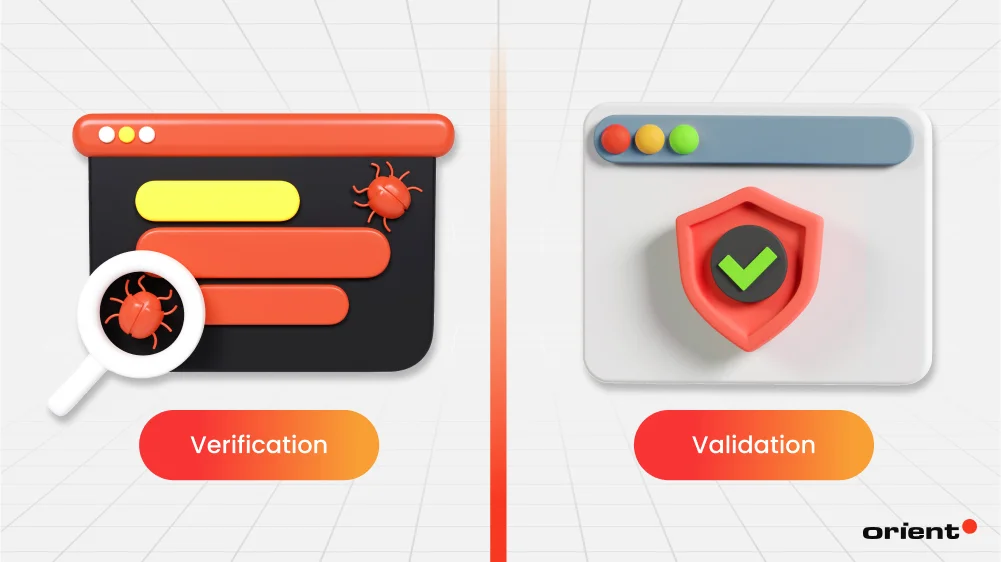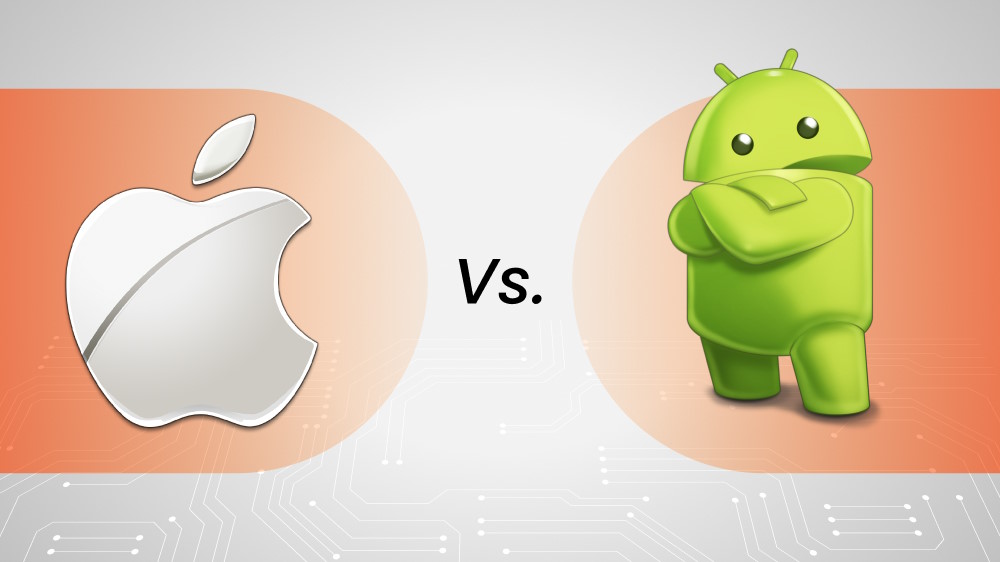Mastering Software Quality: Verification Vs. Validation Testing Demystified
Do you know all the differences between verification and validation tests? Here’s a hint: their differences go beyond their timing in SDLC.

Content Map
More chaptersThe quality assurance process plays a crucial role in a software’s success. Verification and validation testing play major roles in this success. The increasing competitiveness of the market demands that companies deliver high-quality products, free of major bugs and performance issues. This article aims to demystify the differences between verification and validation testing, what roles they play and how they differ in the software development lifecycle.
Key Takeaways:
- Verification testing ensures that the team is building the right product, while validation testing confirms that the product meets users’ expectations. In other words, verification tests are similar to following the blueprint for building a house, while validation tests are like seeing if the house is livable and meets the owners’ needs.
- Typically, verification tests happen during the software development lifecycle, and validation is typically performed after the coding. However, if a part of a design is completed, validation testing can happen at the early stages of the SLDC, too.
- Verification tests are static, focusing on meeting the original requirements and minimizing any errors that the team might encounter later. Validation tests are dynamic and examine if the test meets end-users’ expectations.
- The evolution of verification and validation tests has proven that businesses are putting more emphasis on secure development and products.
What’s Verification Testing?
Definition
Verification testing evaluates whether a system or component meets specified requirements and adheres to design standards. It involves reviewing work products like specifications, design documents, and code to ensure the product is built correctly, without executing the software. Essentially, it answers the question: Are we building the product right? This means the verification test is done during the software development lifecycle (SDLC). In reality, a secure SDLC entails several software tests, e.g. performance and load testing, API calls, and GUI acceptance tests. Still, various vulnerabilities can slip through. Verification tests work to identify all of them fully. This is why they consist of several protocols and procedures, including:
- Peer reviews: This process requests those involved to review the product and provide observations to improve the product quality.
- Assessments: A dedicated team identifies and identifies vulnerabilities that need to be addressed.
- Walkthrough: By showing others a demo of the software and allowing questions, the team collects feedback and spots more potential issues.
- Desk-checking: The development team examines the source code to ensure that every line and algorithm is operating as intended.

What Are the Advantages of Verification Testing?
Verification testing plays a vital role in assuring that the overall software development process is heading in the right direction.
- Verification tests ensure that hardware, documentation, and software – in other words, all the developmental elements – meet industry and organizational-specific standards and protocols.
- The verification test’s early detection of bugs reduces the number of defects detected in later stages.
- Constant verifying during the development stage ensures that all relevant stakeholders have a comprehensive understanding of the product, what can be improved, and if the product meets the original requirements.
- With bugs or vulnerabilities that can’t be dealt with immediately, the tests still give QA and development teams time and space to work out suitable solutions.
- The final reports of verification testing help determine whether the product is ready for the next stage of development.
What’s Validation Testing?
Definition
Validation testing ensures that a software product meets the needs and expectations of its stakeholders and end users. It evaluates whether the software fulfills its intended purpose by simulating real-world scenarios and comparing the actual outcomes to the expected results. Unlike verification, which focuses on building the product right, validation answers the question: Did we build the right product?
This dynamic testing phase typically occurs post-production. Validation tests are important since they ensure the software meets end-user needs and garners a positive response. This ultimately leads to an increase in sales and a stronger company reputation.

Validation Testing Phases and Techniques
Similar to verification tests, validation tests consist of several testing processes and techniques. The common test processes are:
- Planning: The team comes up with the test’s objective, acceptance criteria and necessary tasks.
- Design: The team designs specific tests to validate compliance and identify any errors or vulnerabilities.
- Execution: The team executes and records the test results and examines if the acceptance criteria are met
- Evaluation: The results and reports are analyzed to determine if the product meets the requirements.
In addition to the testing steps, there are a variety of techniques applied. Most QA tests fall under the category of validation testing. Some of them include:
- Unit testing ensures that individual components of the code function as expected.
- Integration testing evaluates how well the components interact with one another.
- System testing examines the overall performance of the entire system in conditions that mimic real-world usage.
- Acceptance testing confirms whether the software meets its defined functional requirements.
- Security testing identifies potential vulnerabilities and assesses the system’s ability to withstand various threats.
- Performance testing measures how the system operates under varying loads, including extreme conditions.
What Are the Advantages of Validation Testing?
The main purpose of validation testing is to ensure the final software meets end-users’ requirements. Other benefits of validation testing include:
- Fully capture any bugs or vulnerabilities missed during verification testing.
- The test ensures that the product meets expectations regarding performance or speed under different circumstances, e.g. peak seasons or slow connectivity.
- Validation testing tracks quantifiable metrics to ensure cross-browser compatibility. This means the final product should work seamlessly, whether it is on an iOS device or Android device, for example.
- Often, the inefficiency of requirements during this stage can be difficult and time-consuming to fix. Still, in today’s narrow and crowded market, businesses can’t afford to introduce a poor-quality product.
The Evolving Role of Verification and Validation Tests in QA
Even though traditional SDLC performed tasks to control the software’s quality, it wasn’t the main focus of the process. Traditionally, developers were more focused on clean code lines.
However, as software practices have matured, so have quality assurance processes. Validation and verification testing are playing pivotal roles in modern quality assurance. Secure, modern SDLCs integrate security into their core functions, with verification tests ensuring alignment with design specifications and validation tests adopting a user-focused approach to confirm that the software fulfills its intended purpose.
Together, verification and validation testing provide a comprehensive quality assurance that minimizes vulnerabilities and enhances reliability and usability.
Verification Vs. Validation Testing: Key Differences

To summarize the difference between verification and validation testing, you can think of the process of cooking a meal.
- Verification testing is making sure you follow the recipe correctly. This means you measure the ingredients correctly, set the appropriate temperature, season the right amount of salt and pepper, and time each step as directed.
- Validation testing is tasting the final dish and determining if the flavors are balanced, the texture is pleasurable, and if it meets the expectations regarding appearance and satisfaction.
So, though some may use these terms interchangeably, they still carry important distinctions, as presented in this table.
| Verification Testing | Validation Testing | |
|---|---|---|
| Timing in SLDC | Takes place during every stage of the SDLC Before the implementation phase in the SDLC | Takes place post-coding Usually the end of the project |
| Nature of test | Static processes and activities Review and design tests without coding execution | Dynamic processes and activities Running the software to ensure usability, functionality, and suitability |
| Data used | Sample data | Real-world data |
| The focus of the test | Alignment with original requirements | Whether the final product meets the expectations of relevant stakeholders |
| Basis of the Process | Checks adherence to requirements Reviewing documents and design | Code execution to validate its functions against customer expectations |
| Requirements | Understand the software’s requirements | Understand the user’s demands |
| Who performs the test | Developers and QA team | QA team, third-party QA testers, end-users |
| Tools and Methods used | Checklists Walkthroughs Peer reviews Static analysis tools | Test cases Prototypes Dynamic analysis tools Actual system execution |
| Manual/ Automated | Can be both manual and automated | Mostly involves manual testing |
| Error Handling | Detect errors in the early phases Ensures consistency Minimizes costly rework | Identify gaps post-production Ensures product meets end-users’ expectations |
| Example | Unit testing, integration testing | User acceptance test (UAT), prototype validation |
Verification Vs. Validation Testing: Choosing the Right Approach

Based on the key differences between verification and validation testing, it’s easy to assume the timing to apply verification tests (during the developmental stages) and when to apply validation tests (after code execution). While this is technically true, other factors come into play when you and your team choose the time to apply which kind of test.
When to Use Verification Tests
There are several scenarios where verification tests come in handy.
- Before user acceptance testing: UAT involves real-world testing, so verification tests ensure the software is free from any major errors.
- Before code integration: Before combining lines of code into the bigger system, developers need to check to make sure it meets requirements on its own. Performing verification tests during this phase ensures any errors are caught early on.
- During design reviews, verification tests help determine whether a new feature meets the basic requirements.
- Following software updates: The tests ensure that the updates satisfy the requirements and standards without causing any problems.
- During system integration: This test determines whether the integrated system satisfies all specified requirements and performs as intended.
- Requirement changes: Since verification aims to ensure requirements are met, any changes in demands require tests to check if the system aligns with the new expectations.
When to Use Validation Tests
With the main aim of meeting relevant stakeholders’ expectations, they are commonly utilized in the following scenarios.
- During UAT: If verification tests happen before UATs, validation tests are performed during UATs to check if the software meets the demands of the real world.
- After system completion: Validation tests examine the product as a whole to make sure there are no errors, and all the original standards are met.
- Before launch: To confirm that the product functions as it should in the real world.
- After major changes: When there are major updates or new feature updates, they need to go through validation tests.
- During beta testing: The best way to guarantee that the final product meets users’ expectations is by gathering feedback from the users themselves. This feedback is valuable so the team can introduce the best possible product to the market.
- Post-deployment: Even after the product is deployed, testing activities are not over. The maintenance and constant improvement are what deliver the best user experience.
Final Note
Verification tests and validation tests both play unique roles in guaranteeing a software’s overall quality and seamless user experience. Think of them as the yin and yang of quality assurance—opposite, but perfectly complementary. Understanding what each test entails allows businesses to deliver users with software products that exceed expectations.
If you are looking for a team of reliable professionals to elevate your quality assurance game, look no further than Orient Software! Our team of professionals will help you deliver reliable software that your users will trust and love.







